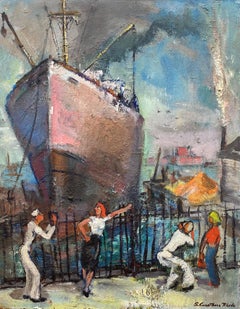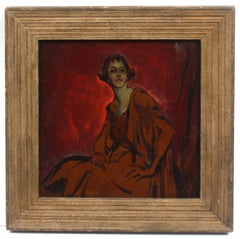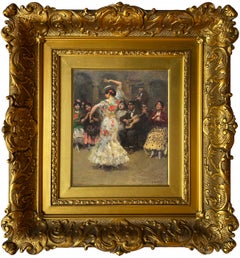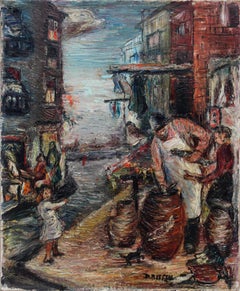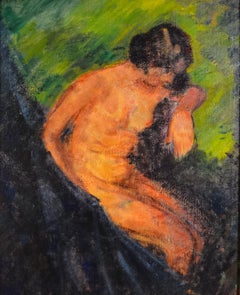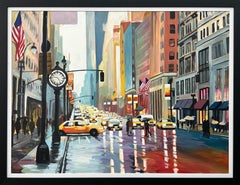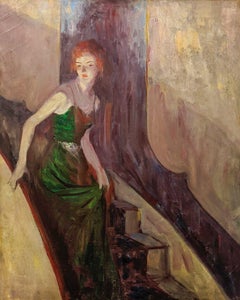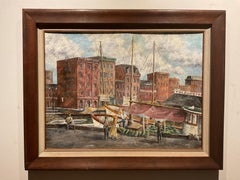Ashcan School Figurative Paintings
to
4
5
7
3
4
1
Overall Width
to
Overall Height
to
20
4
3
4
1
3
15,532
5,140
3,435
3,265
1,486
1,396
1,321
1,228
498
490
382
183
110
79
13
6
1
17
14
8
8
4
4
3
2
2
2
1
1
1
1
1
1
1
1
15
14
6
5
5
3
1
1
1
1
14
1
20
Style: Ashcan School
“Fleet Week”
Located in Southampton, NY
Original oil on masonite painting of Fleet Week with sailors flirting with young women on the dock by the American artist, Sarah Pace Carothers Rhode. ...
Category
1940s Ashcan School Figurative Paintings
Materials
Oil, Masonite
$2,400 Sale Price
33% Off
Woman in Red
Located in Buffalo, NY
Alexander O. Levy was a painter, illustrator,
printmaker and designer who was born in 1881 in Bonn, Germany. He
died in 1946 in Buffalo, New York. At age three, he was brought to
...
Category
1920s Ashcan School Figurative Paintings
Materials
Oil, Wood Panel
$4,000 Sale Price
20% Off
Portrait of Stylish Woman
By George Luks
Located in Wilton Manors, FL
Beautiful Ashcan School portrait of a woman in winter outerwear, 1909.
Oil on canvas panel, measuring 17.75 x 18 inches; 21.75 x 22 inches framed. Original frame.
Dated lower rig...
Category
Early 1900s Ashcan School Figurative Paintings
Materials
Oil, Board
Flamenco Dancer, Sevilla, Spain
Located in New York, NY
Francis Mora is often considered to be the American artist who most depicted Hispanic culture in American and abroad. He made a trip to Spain in the early 1900's and created mostly ...
Category
Early 1900s Ashcan School Figurative Paintings
Materials
Oil, Board
The Fishmonger 1940's New York Impasto Figurative Cityscape
By Dorothy Rossen Greenberg
Located in Soquel, CA
A vivid mid-century impasto figurative cityscape oil painting of New York during the 1940s by Dorothy Rossen Greenberg (American, 1915-2005). A Fishmonger plies his trade amidst a ha...
Category
1940s Ashcan School Figurative Paintings
Materials
Oil, Linen
"Female Nude, " Edith Glackens Dimock, Ashcan School Figurative Painting
By Edith Glackens Dimock
Located in New York, NY
Edith (Glackens) Dimock (1876 - 1955)
Untitled (Female Nude), circa 1915
Oil on canvas
34 1/2 x 28 1/4 inches
Signed lower left
Provenance:
Private Colle...
Category
1910s Ashcan School Figurative Paintings
Materials
Canvas, Oil
"Beach at Atlantic City, New Jersey" Amy Londoner, Ashcan School, Figurative
By Amy Londoner
Located in New York, NY
Amy Londoner
Beach at Atlantic City, circa 1922
Signed lower right
Pastel on paper
Sight 23 x 18 inches
Amy Londoner (April 12, 1875 – 1951) was an American painter who exhibited at the 1913 Armory Show. One of the first students of the Henri School of Art in 1909. Prior to the Armory Show of 1913, Amy Londoner and her classmates studied with "Ashcan" painter Robert Henri at the Henri School of Art in New York, N.Y. One notable oil painting, 'The Vase', was painted by both Henri and Londoner.
Londoner was born in Lexington, Missouri on April 12, 1875. Her parents were Moses and Rebecca Londoner, who moved to Leadville, Colorado, by 1880. In 1899, Amy took responsibility for her father who had come to Los Angeles from Leadville and had mental issues. By 1900, Amy was living with her parents and sister, Blanche, in the vicinity of Leadville, Denver, Colorado. While little was written about her early life, Denver City directories indicated that nineteenth-century members of the family were merchants, with family ties to New York, N.Y. The family had a male servant. Londoner traveled with her mother to England in 1907 then shortly later, both returned to New York in 1909. Londoner was 34 years old at the time, and, according to standards of the day, should have married and raised a family long before. Instead, she enrolled as one of the first students at the Henri School of Art in 1909.
At the Henri School, Londoner established friendships with Carl Sprinchorn (1887-1971), a young Swedish immigrant, and Edith Reynolds (1883-1964), daughter of wealthy industrialist family from Wilkes-Barre, PA. Londoner's correspondence, which often included references to Blanche, listed the sisters' primary address as the Hotel Endicott at 81st Street and Columbus Avenue, NYC. Other correspondence also reached Londoner in the city via Mrs. Theodore Bernstein at 252 West 74th Street; 102 West 73rd Street; and the Independent School of Art at 1947 Broadway. In 1911, Londoner vacationed at the Hotel Trexler in Atlantic City, NJ. As indicated by an undated photograph, Londoner also spent time with Edith Reynolds and Robert Henri at 'The Pines', the Reynolds family estate in Bear Creek, PA.
Through her connections with the Henri School, Londoner entered progressive social and professional circles. Henri's admonition, phrased in the vocabulary of his historical time period, that one must become a "man" first and an artist second, attracted both male and female students to classes where development of unique personal styles, tailored to convey individual insights and experiences, was prized above the mastery of standardized, technical skill. Far from being dilettantes, women students at the Henri School were daring individuals willing to challenge tradition. As noted by former student Helen Appleton Read, "it was a mark of defiance,to join the radical Henri group."
As Henri offered educational alternatives for women artists, he initiated exhibition opportunities for them as well. Troubled by the exclusion of work by younger artists from annual exhibitions at the National Academy of Design, Henri was instrumental in organizing the no-jury, no-prize Exhibition of Independent Artists in 1910. About half of the 103 artists included in the exhibition were or had been Henri students, while twenty of the twenty-six women exhibiting had studied with Henri. Among the exhibition's 631 pieces, nine were by Amy Londoner, including the notorious 'Lady with a Headache'. Similarly, fourteen of Henri's women students exhibited in the groundbreaking Armory Show of 1913, forming about eight percent of the American exhibitors and one-third of American women exhibitors. Of the nine documented works submitted by Londoner, five were rejected, while four pastels of Atlantic City beach scenes, including 'The Beach Umbrellas' now in the Remington Collection, were displayed.
Following Henri's example, Londoner served as an art instructor for younger students at the Modern School, whose only requirement was to genuinely draw what they pleased. The work of dancer Isadora Duncan, another artist devoted to the ideals of a liberal education, was also lauded by the Modern School. Henri, who long admired Duncan and invited members of her troupe to model for his classes, wrote an appreciation of her for the Modern School journal in 1915. She was also the subject of Londoner's pastel Isadora Duncan and the Children: Praise Ye the Lord with Dance. In 1914, Londoner traveled to France to spend summer abroad, living at 99 rue Notre Dames des Champs, Paris, France. As the tenets of European modernism spread throughout the United States, Londoner showed regularly at venues which a new generation of artists considered increasingly passe, including the annual Society of Independent Artists' exhibitions between 1918 and 1934, and the Salons of America exhibition in 1922. Londoner also exhibited at the Morton Gallery, Opportunity Gallery, Leonard Clayton Gallery and Brownell-Lambertson Galleries in NYC. Her painting of a 'Blond Girl' was one of two works included in the College Art Associations Traveling Exhibition of 1929, which toured colleges across the country to broad acclaim.
Londoner later in life suffered from illnesses then suffered a stroke which resulted in medical bills significantly mounting over the years that her old friends from the Henri School, including Carl Sprinchorn, Florence Dreyfous, Florence Barley, and Josephine Nivison Hopper, scrambled to raise funds and find suitable long-term care facilities for Londoner. Londoner later joined Reynolds in Bear Creek, PA. Always known for her keen wit, Londoner retained her humor and concern for her works even during her illness, noting that "if anything happens to the Endicott, I guess they will just throw them out." Sprinchorn and Reynolds, however, did not allow this to happen. In 1960, Londoner's paintings 'Amsterdam Avenue at 74th Street' and 'The Builders' were loaned by Reynolds to a show commemorating the Fiftieth Anniversary of the Exhibition of Independent Artists in 1910, presented at the Delaware Art Center, Wilmington, DE. In the late 80's, Francis William Remington, 'Bill Remington', of Bear Creek Village PA, along with his neighbor and artist Frances Anstett Brennan, both had profound admiration for Amy Londoner's art work and accomplishments as a woman who played a significant role in the Ashcan movement. Remington acquired a significant number of Londoner's artwork along with Frances Anstett Brenan that later was part of an exhibition of Londoner's artwork in April 15 of 2007, at the Hope Horn...
Category
1920s Ashcan School Figurative Paintings
Materials
Paper, Pastel
Tugboat
Located in Saratoga Springs, NY
This vivid oil on board, signed by Abraham P. Hankins, showcases the artist's engagement with urban and industrial themes. Titled Tugboat, the work captures a bold red tugboat positi...
Category
1940s Ashcan School Figurative Paintings
Materials
Oil, Board
$4,850
Modernist Oil Painting the Shop Window NYC 1940s WPA era
Located in Surfside, FL
the Shop Window New York City, 1940s
17.75X25 sight size.
Maurice Becker (1889–1975) was a radical political artist best known for his work in the 1910s and 1920s for such publica...
Category
Early 20th Century Ashcan School Figurative Paintings
Materials
Oil, Board
“Untitled (Women Walking), c. 1945” by Reginald Marsh NYC Street Double-Sided
Located in Yardley, PA
A fantastic example of Marsh’s renowned depictions of ladies walking in downtown Manhattan. This richly worked ink and wash composition captures a sidewalk populated by stylish women...
Category
Mid-20th Century Ashcan School Figurative Paintings
Materials
Paper, Ink, Watercolor
Early 20th Century Ashcan Portrait of Woman Illuminated by Moonlight
Located in Soquel, CA
Early 20th Century Portrait of Woman Illuminated by Moonlight by Everett Shinn
This is a pastel on canvas portrait by Everett Shinn ((1876 - 1953), circa early 20th Century. A softl...
Category
Early 20th Century Ashcan School Figurative Paintings
Materials
Canvas, Pastel
“The Rabbi’s”
Located in Southampton, NY
Original oil on canvas painting by the well known Russian/American artist, Nahum Tschacbasov.. The painting depicts a group of rabbi’s in conversation in an interior setting. Circa 1...
Category
1930s Ashcan School Figurative Paintings
Materials
Canvas, Oil
"After the Storm"
Located in Lambertville, NJ
Signed LL
John Grabach was a highly regarded New Jersey artist, teacher and author of a classic text, How to Draw the Human Figure. He was born in Massachusetts, and with his widow...
Category
20th Century Ashcan School Figurative Paintings
Materials
Oil, Panel
“The Maitre d’”
Located in Southampton, NY
Here for your consideration is a comical take on the position of maitre d’. Unsigned. Framed in a new African mahogany frame. Overall measurements are 25.5 by 17.5 inches. Oil pain...
Category
1910s Ashcan School Figurative Paintings
Materials
Oil, Fiberboard
$1,480 Sale Price
20% Off
"Musical Conductor" Amy Londoner, Ashcan School, Figurative Concert Scene
By Amy Londoner
Located in New York, NY
Amy Londoner
Musical Conductor, 1922
Signed and dated lower right
Pastel on paper
Sight 18 x 23 inches
Amy Londoner (April 12, 1875 – 1951) was an American painter who exhibited at the 1913 Armory Show. One of the first students of the Henri School of Art in 1909. Prior to the Armory Show of 1913, Amy Londoner and her classmates studied with "Ashcan" painter Robert Henri at the Henri School of Art in New York, N.Y. One notable oil painting, 'The Vase', was painted by both Henri and Londoner.
Londoner was born in Lexington, Missouri on April 12, 1875. Her parents were Moses and Rebecca Londoner, who moved to Leadville, Colorado, by 1880. In 1899, Amy took responsibility for her father who had come to Los Angeles from Leadville and had mental issues. By 1900, Amy was living with her parents and sister, Blanche, in the vicinity of Leadville, Denver, Colorado. While little was written about her early life, Denver City directories indicated that nineteenth-century members of the family were merchants, with family ties to New York, N.Y. The family had a male servant. Londoner traveled with her mother to England in 1907 then shortly later, both returned to New York in 1909. Londoner was 34 years old at the time, and, according to standards of the day, should have married and raised a family long before. Instead, she enrolled as one of the first students at the Henri School of Art in 1909.
At the Henri School, Londoner established friendships with Carl Sprinchorn (1887-1971), a young Swedish immigrant, and Edith Reynolds (1883-1964), daughter of wealthy industrialist family from Wilkes-Barre, PA. Londoner's correspondence, which often included references to Blanche, listed the sisters' primary address as the Hotel Endicott at 81st Street and Columbus Avenue, NYC. Other correspondence also reached Londoner in the city via Mrs. Theodore Bernstein at 252 West 74th Street; 102 West 73rd Street; and the Independent School of Art at 1947 Broadway. In 1911, Londoner vacationed at the Hotel Trexler in Atlantic City, NJ. As indicated by an undated photograph, Londoner also spent time with Edith Reynolds and Robert Henri at 'The Pines', the Reynolds family estate in Bear Creek, PA.
Through her connections with the Henri School, Londoner entered progressive social and professional circles. Henri's admonition, phrased in the vocabulary of his historical time period, that one must become a "man" first and an artist second, attracted both male and female students to classes where development of unique personal styles, tailored to convey individual insights and experiences, was prized above the mastery of standardized, technical skill. Far from being dilettantes, women students at the Henri School were daring individuals willing to challenge tradition. As noted by former student Helen Appleton Read, "it was a mark of defiance,to join the radical Henri group."
As Henri offered educational alternatives for women artists, he initiated exhibition opportunities for them as well. Troubled by the exclusion of work by younger artists from annual exhibitions at the National Academy of Design, Henri was instrumental in organizing the no-jury, no-prize Exhibition of Independent Artists in 1910. About half of the 103 artists included in the exhibition were or had been Henri students, while twenty of the twenty-six women exhibiting had studied with Henri. Among the exhibition's 631 pieces, nine were by Amy Londoner, including the notorious 'Lady with a Headache'. Similarly, fourteen of Henri's women students exhibited in the groundbreaking Armory Show of 1913, forming about eight percent of the American exhibitors and one-third of American women exhibitors. Of the nine documented works submitted by Londoner, five were rejected, while four pastels of Atlantic City beach scenes, including 'The Beach Umbrellas' now in the Remington Collection, were displayed.
Following Henri's example, Londoner served as an art instructor for younger students at the Modern School, whose only requirement was to genuinely draw what they pleased. The work of dancer Isadora Duncan, another artist devoted to the ideals of a liberal education, was also lauded by the Modern School. Henri, who long admired Duncan and invited members of her troupe to model for his classes, wrote an appreciation of her for the Modern School journal in 1915. She was also the subject of Londoner's pastel Isadora Duncan and the Children: Praise Ye the Lord with Dance. In 1914, Londoner traveled to France to spend summer abroad, living at 99 rue Notre Dames des Champs, Paris, France. As the tenets of European modernism spread throughout the United States, Londoner showed regularly at venues which a new generation of artists considered increasingly passe, including the annual Society of Independent Artists' exhibitions between 1918 and 1934, and the Salons of America exhibition in 1922. Londoner also exhibited at the Morton Gallery, Opportunity Gallery, Leonard Clayton Gallery and Brownell-Lambertson Galleries in NYC. Her painting of a 'Blond Girl' was one of two works included in the College Art Associations Traveling Exhibition of 1929, which toured colleges across the country to broad acclaim.
Londoner later in life suffered from illnesses then suffered a stroke which resulted in medical bills significantly mounting over the years that her old friends from the Henri School, including Carl Sprinchorn, Florence Dreyfous, Florence Barley, and Josephine Nivison Hopper, scrambled to raise funds and find suitable long-term care facilities for Londoner. Londoner later joined Reynolds in Bear Creek, PA. Always known for her keen wit, Londoner retained her humor and concern for her works even during her illness, noting that "if anything happens to the Endicott, I guess they will just throw them out." Sprinchorn and Reynolds, however, did not allow this to happen. In 1960, Londoner's paintings 'Amsterdam Avenue at 74th Street' and 'The Builders' were loaned by Reynolds to a show commemorating the Fiftieth Anniversary of the Exhibition of Independent Artists in 1910, presented at the Delaware Art Center, Wilmington, DE. In the late 80's, Francis William Remington, 'Bill Remington', of Bear Creek Village PA, along with his neighbor and artist Frances Anstett Brennan, both had profound admiration for Amy Londoner's art work and accomplishments as a woman who played a significant role in the Ashcan movement. Remington acquired a significant number of Londoner's artwork along with Frances Anstett Brenan that later was part of an exhibition of Londoner's artwork in April 15 of 2007, at the Hope Horn...
Category
1920s Ashcan School Figurative Paintings
Materials
Paper, Pastel
"Night Stroll" Amy Londoner, Ashcan School, Figurative Nocturne
By Amy Londoner
Located in New York, NY
Amy Londoner
Beach at Atlantic City, circa 1922
Signed lower right
Pastel on paper
Sight 23 x 18 inches
Amy Londoner (April 12, 1875 – 1951) was an American painter who exhibited at the 1913 Armory Show. One of the first students of the Henri School of Art in 1909. Prior to the Armory Show of 1913, Amy Londoner and her classmates studied with "Ashcan" painter Robert Henri at the Henri School of Art in New York, N.Y. One notable oil painting, 'The Vase', was painted by both Henri and Londoner.
Londoner was born in Lexington, Missouri on April 12, 1875. Her parents were Moses and Rebecca Londoner, who moved to Leadville, Colorado, by 1880. In 1899, Amy took responsibility for her father who had come to Los Angeles from Leadville and had mental issues. By 1900, Amy was living with her parents and sister, Blanche, in the vicinity of Leadville, Denver, Colorado. While little was written about her early life, Denver City directories indicated that nineteenth-century members of the family were merchants, with family ties to New York, N.Y. The family had a male servant. Londoner traveled with her mother to England in 1907 then shortly later, both returned to New York in 1909. Londoner was 34 years old at the time, and, according to standards of the day, should have married and raised a family long before. Instead, she enrolled as one of the first students at the Henri School of Art in 1909.
At the Henri School, Londoner established friendships with Carl Sprinchorn (1887-1971), a young Swedish immigrant, and Edith Reynolds (1883-1964), daughter of wealthy industrialist family from Wilkes-Barre, PA. Londoner's correspondence, which often included references to Blanche, listed the sisters' primary address as the Hotel Endicott at 81st Street and Columbus Avenue, NYC. Other correspondence also reached Londoner in the city via Mrs. Theodore Bernstein at 252 West 74th Street; 102 West 73rd Street; and the Independent School of Art at 1947 Broadway. In 1911, Londoner vacationed at the Hotel Trexler in Atlantic City, NJ. As indicated by an undated photograph, Londoner also spent time with Edith Reynolds and Robert Henri at 'The Pines', the Reynolds family estate in Bear Creek, PA.
Through her connections with the Henri School, Londoner entered progressive social and professional circles. Henri's admonition, phrased in the vocabulary of his historical time period, that one must become a "man" first and an artist second, attracted both male and female students to classes where development of unique personal styles, tailored to convey individual insights and experiences, was prized above the mastery of standardized, technical skill. Far from being dilettantes, women students at the Henri School were daring individuals willing to challenge tradition. As noted by former student Helen Appleton Read, "it was a mark of defiance,to join the radical Henri group."
As Henri offered educational alternatives for women artists, he initiated exhibition opportunities for them as well. Troubled by the exclusion of work by younger artists from annual exhibitions at the National Academy of Design, Henri was instrumental in organizing the no-jury, no-prize Exhibition of Independent Artists in 1910. About half of the 103 artists included in the exhibition were or had been Henri students, while twenty of the twenty-six women exhibiting had studied with Henri. Among the exhibition's 631 pieces, nine were by Amy Londoner, including the notorious 'Lady with a Headache'. Similarly, fourteen of Henri's women students exhibited in the groundbreaking Armory Show of 1913, forming about eight percent of the American exhibitors and one-third of American women exhibitors. Of the nine documented works submitted by Londoner, five were rejected, while four pastels of Atlantic City beach scenes, including 'The Beach Umbrellas' now in the Remington Collection, were displayed.
Following Henri's example, Londoner served as an art instructor for younger students at the Modern School, whose only requirement was to genuinely draw what they pleased. The work of dancer Isadora Duncan, another artist devoted to the ideals of a liberal education, was also lauded by the Modern School. Henri, who long admired Duncan and invited members of her troupe to model for his classes, wrote an appreciation of her for the Modern School journal in 1915. She was also the subject of Londoner's pastel Isadora Duncan and the Children: Praise Ye the Lord with Dance. In 1914, Londoner traveled to France to spend summer abroad, living at 99 rue Notre Dames des Champs, Paris, France. As the tenets of European modernism spread throughout the United States, Londoner showed regularly at venues which a new generation of artists considered increasingly passe, including the annual Society of Independent Artists' exhibitions between 1918 and 1934, and the Salons of America exhibition in 1922. Londoner also exhibited at the Morton Gallery, Opportunity Gallery, Leonard Clayton Gallery and Brownell-Lambertson Galleries in NYC. Her painting of a 'Blond Girl' was one of two works included in the College Art Associations Traveling Exhibition of 1929, which toured colleges across the country to broad acclaim.
Londoner later in life suffered from illnesses then suffered a stroke which resulted in medical bills significantly mounting over the years that her old friends from the Henri School, including Carl Sprinchorn, Florence Dreyfous, Florence Barley, and Josephine Nivison Hopper, scrambled to raise funds and find suitable long-term care facilities for Londoner. Londoner later joined Reynolds in Bear Creek, PA. Always known for her keen wit, Londoner retained her humor and concern for her works even during her illness, noting that "if anything happens to the Endicott, I guess they will just throw them out." Sprinchorn and Reynolds, however, did not allow this to happen. In 1960, Londoner's paintings 'Amsterdam Avenue at 74th Street' and 'The Builders' were loaned by Reynolds to a show commemorating the Fiftieth Anniversary of the Exhibition of Independent Artists in 1910, presented at the Delaware Art Center, Wilmington, DE. In the late 80's, Francis William Remington, 'Bill Remington', of Bear Creek Village PA, along with his neighbor and artist Frances Anstett Brennan, both had profound admiration for Amy Londoner's art work and accomplishments as a woman who played a significant role in the Ashcan movement. Remington acquired a significant number of Londoner's artwork along with Frances Anstett Brenan that later was part of an exhibition of Londoner's artwork in April 15 of 2007, at the Hope Horn...
Category
1910s Ashcan School Figurative Paintings
Materials
Paper, Pastel
$3,200 Sale Price
20% Off
SISTERS AT THE WINDOW
By John Sloan
Located in Portland, ME
Sloan, John. SISTERS AT THE WINDOW. Etching, 1923 (M. 208). 5" x 4", signed and titled in pencil and inscribed "100 Proofs," of which only 76 were printed this being one of 25 early ...
Category
1920s Ashcan School Figurative Paintings
Materials
Etching
Children Playing on The Slide, Ashcan School - Lower East Side
By Jerome Myers
Located in Miami, FL
Immigrant children from New York's Lower East Side are joyfully captured whizzing down on a slide. From the window of a tenement building, a lone adult with child witnesses the foli...
Category
Early 1900s Ashcan School Figurative Paintings
Materials
Canvas, Oil
"Jazz Club"
By Jane Gibbs
Located in Lambertville, NJ
Signed Lower Left
Category
20th Century Ashcan School Figurative Paintings
Materials
Canvas, Oil
$31,000
Portrait of a Slum Boy Ashcan School
Located in Miami, FL
Signed upper right
Private Collection
Luks was famous for painting people from impoverished slum areas.
The work was most likely painted from life and portrays a youth haphazardly dressed. Luks describes the subject in quick rapid-fire brush...
Category
Early 1900s Ashcan School Figurative Paintings
Materials
Oil
Related Items
Large Painting of Classic New York City in Rain with Figures by British Artist
Located in Preston, GB
Large Original Painting of a Classic 1990's Busy New York City Scene in the Rain, with Yellow Taxis, Cars and Figures, by British Urban Landscape Artist, Angela Wakefield. This is a ...
Category
2010s Ashcan School Figurative Paintings
Materials
Gesso, Canvas, Linen, Paint, Cotton Canvas, Mixed Media, Oil, Acrylic
Angela WakefieldLarge Painting of Classic New York City in Rain with Figures by British Artist, 2023
$34,743 Sale Price
25% Off
H 41 in W 53 in D 1.75 in
Painting of New York City Street after Rain with Figures, Cars by British Artist
Located in Preston, GB
Original Painting of a Contemporary New York City Scene after the Rain, with Cars and Figures, by British Urban Landscape Artist, Angela Wakefield. This is a major work to continue h...
Category
2010s Ashcan School Figurative Paintings
Materials
Gesso, Canvas, Linen, Paint, Cotton Canvas, Mixed Media, Oil, Acrylic
$26,726 Sale Price
20% Off
H 41 in W 41 in D 1.75 in
Nude. A sitter - Figurative Oil Realistic painting, Interior, Female
Located in Warsaw, PL
AGNIESZKA STAAK-JANCZARSKA (born in 1994)
A graduate of the State Secondary School of Art of Józef Kluza in Krakow. In 2020, she graduated from the Academy of Fine Arts in Krakow in painting at the studio of prof. Janusz Matuszewski.
Selected achievements:
2019 - Award of the Rector of the University of Rzeszów
2019 - Scholarship of the Rector of the Academy of Fine Arts in Krakow
2020 - Finalist of the Polish National Painting Competition Leon Wyczółkowski...
Category
2010s Ashcan School Figurative Paintings
Materials
Oil, Cardboard
Agnieszka Staak-JanczarskaNude. A sitter - Figurative Oil Realistic painting, Interior, Female, 2020
$282 Sale Price
20% Off
H 13.78 in W 10.24 in
Academic Study
Located in London, GB
Oil on Canvas
46cm × 37cm (57cm × 49cm framed)
Until the 1930s, this painting was considered to be by Théodore Géricault. Indeed, since its creation c.1810, it has been sold twice a...
Category
19th Century Ashcan School Figurative Paintings
Materials
Canvas, Oil
A Young Girl Reading a Book, Pointillist Artist
Located in Stockholm, SE
"A Young Girl Reading a Book" is a captivating portrait by Swedish artist Gustaf Arnolds.
Arnolds was a prolific painter whose roots began in Vingåker and later in Ronneby from his teenage years.
His educational journey in art took him through prestigious institutions such as Althins målarskola and the Tallbergska grafikskolan in Stockholm,
followed by a significant period at the Konstakademien, Stockholm, between 1904 and 1909. His talent and dedication were recognized early on, earning him a scholarship to Paris, a city that would deeply influence his artistic direction.
This particular work, likely painted shortly after his return to Sweden, reveals a profound influence from his time in Paris. It portrays a young girl absorbed in reading a book, a simple yet profound subject that Arnolds imbues with a sense of tranquility and introspection. The background hints at a serene landscape, dotted with quaint houses, a nod to the everyday beauty surrounding us. What sets this piece apart is Arnolds’ technique, reminiscent of pointillism but distinguished by longer, more expressive brush strokes that add a vibrant texture and depth to the canvas. This method showcases Arnolds' unique adaptation of the techniques he encountered during his Parisian studies, particularly during his interactions with Nils Dardel...
Category
1930s Ashcan School Figurative Paintings
Materials
Masonite, Oil
$1,692 Sale Price
20% Off
H 16.15 in W 13.39 in
SISTERS AT THE WINDOW
By John Sloan
Located in Portland, ME
Sloan, John. SISTERS AT THE WINDOW. Etching, 1923 (M. 208). 5" x 4", signed and titled in pencil and inscribed "100 Proofs," of which only 76 were printed this being one of 25 early ...
Category
1920s Ashcan School Figurative Paintings
Materials
Etching
New York City NYC Street Sunshine Landscape Painting by British Cityscape Artist
Located in Preston, GB
New York Sunshine Golden Glow Cityscape Painting by British Urban Landscape Artist Angela Wakefield. This original is part of the New York Series, a ...
Category
2010s Ashcan School Figurative Paintings
Materials
Linen, Canvas, Paint, Cotton Canvas, Oil, Acrylic, Mixed Media
$25,055 Sale Price
25% Off
H 52 in W 40 in D 1.5 in
A Charming, 1950s Mid-Century Modern Harbor Scene of Martha's Vineyard
Located in Chicago, IL
A Charming, Colorful 1950s Mid-Century Modern Harbor Scene of Martha's Vineyard by Notable Chicago Artist, Francis Chapin (Am. 1899-1965). Painted near the artist's longtime studio ...
Category
Mid-20th Century Ashcan School Figurative Paintings
Materials
Masonite, Oil
$950
H 12.25 in W 12 in D 1.25 in
Charming 1950s Painting "Oak Bluffs, Mass." Martha's Vineyard by Francis Chapin
Located in Chicago, IL
A charming vintage 1950s painting of Martha's Vineyard, "Oak Bluffs, Mass." by notable Chicago artist Francis Chapin. A bustling view of the picturesque lighthouse and Soldiers Mem...
Category
1950s Ashcan School Figurative Paintings
Materials
Masonite, Oil
$950
H 12.75 in W 15 in D 1 in
Bathers, Modernist Nudes, Oil on Canvas, Signed and Titled
By Leon Kelly
Located in Doylestown, PA
"Bathers" by Philadelphia born modernist painter Leon Kelly, is a fantasy nude scene of two female figures, one with towel in hand, one only depicted as a portrait within the paintin...
Category
20th Century Ashcan School Figurative Paintings
Materials
Canvas, Oil
$4,125 Sale Price
44% Off
H 21 in W 25 in D 2 in
The Little Flower Seller, British Les Miserables image, Victorian oil painting
Located in Hillsborough, NC
Mesmerizing image, ‘The Little Flower Seller’ is reminiscent of Cosette in Les Miserable, her hair blown to one side and her red ribbon flowing out from her hair. She is that unloved...
Category
Late 19th Century Ashcan School Figurative Paintings
Materials
Oil, Board
$4,000
H 14.5 in W 11.5 in D 1 in
Large Original Painting of Broadway New York City by British Landscape Artist
Located in Preston, GB
Large Atmospheric Black & Yellow Painting of Broadway New York City by British Urban Landscape Artist, Angela Wakefield. This unique original is ...
Category
2010s Ashcan School Figurative Paintings
Materials
Paint, Oil, Linen, Canvas, Cotton Canvas, Acrylic, Mixed Media, Gesso
$19,955
H 41 in W 53 in D 1.75 in
Previously Available Items
"Woman on a Staircase, Sketch" Everett Shinn, Ashcan School, Theater Scene
Located in New York, NY
Everett Shinn
Woman on a Staircase, Sketch, circa 1935
Signed on the reverse and on the stretcher
Oil on canvas
30 x 25 inches
Everett Shinn, a future member of the Eight and remark...
Category
1930s Ashcan School Figurative Paintings
Materials
Canvas, Oil
Rare Baltimore Harbor Oil Painting, Pratt Street Dock, ca 1950 - Rosalie Hamblin
Located in Baltimore, MD
This lively oil painting depicts Baltimore’s busy waterfront, specifically the former piers that lined Pratt Street in the Inner Harbor. Painted by local artist Rosalie Mills ( née Hamblin), the scene depicts the watermelon boats that berthed near Pier 5. The painting dates to the 1950’s. The historic buildings that once lined Pratt Street, before urban renewal clearance of the 1960’s, provide the background for the scene. Hamblin’s attention to detail is quite good and calls to mind other Baltimore painters...
Category
1950s Ashcan School Figurative Paintings
Materials
Oil
1940s New York Interior -- An Evening Scene of Artist and His Wife
Located in Soquel, CA
1940s New York Interior -- An Evening Scene of Artist and His Wife
Wonderful moody 1940s New York interior and figurative oil painting in Ashcan Schoo...
Category
1940s Ashcan School Figurative Paintings
Materials
Oil, Canvas, Cardboard
H 15.5 in W 19.5 in D 0.75 in
Mother and Daughter, Santa Fe, 1919-20
Located in Missouri, MO
Mother and Daughter, Santa Fe, 1919-20
By. John French Sloan (American, 1871-1951)
Signed Lower Right
Unframed: 20 x 24 inches
Framed: 27 x 31.5 inches
Born in Lock Haven, Pennsylva...
Category
Early 20th Century Ashcan School Figurative Paintings
Materials
Canvas, Oil
ASHCAN School Antique Impressionist NYC Orchestra SYMPHONY Violin Painting
By John Howitt
Located in New York, NY
Up for sale is a Finely painted American Ashcan School painting of a NYC Symphony by John Newton Howitt (1885 - 1958).
Most likely painted in the 1...
Category
1920s Ashcan School Figurative Paintings
Materials
Oil
PHILISTINES
Located in Los Angeles, CA
JEAN HALPERT-RYDEN
"PHILISTINES"
OIL ON CANVAS, SIGNED, TITLED
AMERICAN, LIVED IN CALIFORNIA, DATED 1948
24 X 30 INCHES
FRAMED 32 X 38 INCHES
Jean Halpert-Ryden
1919-2011
Jean Halpert-Ryden, painter, was born Jeanette Muriel Halpert in Brooklyn, New York on 26 December 1919 to Mildred and Abraham Halpert.
She studied at Brooklyn College and then studied art under the painter and stage designer Mol Solotaroff in New York City.
Her first exhibition was at the Jimmy Ernst's Norlyst Gallery in Manhattan in 1946.
The following year she married artist and designer Edward Ryden and they moved to Colorado.
In 1949, the couple relocated to the San Francisco Bay Area where Edward worked on his MFA and Jean studied lithography at the California College of Arts and Crafts. They lived in San Francisco but built a second home on Sonoma Mountain...
Category
1940s Ashcan School Figurative Paintings
Materials
Canvas, Oil
"Flower Girl, " John George Brown, Genre Painting, Street Figure
Located in New York, NY
John George Brown (1831 - 1913)
Flower Girl, circa 1900
Watercolor on paper
6 3/4 x 4 3/4 inches
Signed lower left
Period Hand Carved Foster Brothers Fram...
Category
Early 1900s Ashcan School Figurative Paintings
Materials
Paper, Watercolor
"Julie Hyneman at Central Park, New York City, " Herman Hyneman, Gilded Age
Located in New York, NY
Herman N. Hyneman (1849 - 1907)
Julie Hyneman at Central Park
Oil on canvas
25 x 20 inches
Signed lower left
Herman N. Hyneman was a noted American portrait and figure painter with ties to both Philadelphia and New York. He was born July 27,1849 to Leon and Adeline Hyneman in Philadelphia. ("Who Was Who in American Art" lists his birth date as either 1849 or 1859, but we have confirmed that the birth date is 1849).
Virtually nothing is known about his early years, but given the fact that the family resided in a wealthy section of Philadelphia and the fact that he traveled to Paris to study in the studio of Leon Bonnat when he was but 20 years old, it is presumed that the family was financially comfortable if not well to do. Hyneman exhibited at the Paris Salon in 1879 and 1881, which was quite an accomplishment given his tender age.
He returned to the United States in 1882 and after a year in Philadelphia, he established a studio at 58 West 57th Street, New York, NY, where he painted portraits to support himself and scenes of beautiful fair-skinned women walking in the snow to exhibit at major exhibitions throughout the United States.
Hyneman exhibited at the the Brooklyn Art Association in 1882, 1883 and 1884 and at the Pennsylvania Academy of Fine Arts in 1883 and 1888. Beginning in 1882 and continuing up until 1905, he exhibited regularly at the National Academy of Design. Despite the fact that he exhibited fourteen paintings at the National Academy over a span of three different decades, he was never elected as a member.
In the 1880's his paintings sold for between $100 and $1500, which were substantial sums for that period. Hyneman also exhibited at the Salmagundi Club and the Philadelphia Art Club and was a member of each organization. He won a medal at the American Art Society in 1904 and also exhibited at the Chicago Art Institute. A handwritten label on one of his paintings indicates that he also exhibited in Budapest, Hungary.
In 1892, Hyneman married the noted artist Juliet Jolley (aka Jolly), who had previously modeled for him. Thereafter, they shared a studio and on at least one occasion exhibited together. The February 5, 1896 edition of the "New York Times" reported on a "pleasant studio reception" at 58 West 57th Street where the paintings of both Herman and Juliet were shown to members of New York Society including Mr. And Mrs. Edwin Blashfield.
At least one of Hyneman's Painting " A Sensation on Wall Street" which depicted a lovely young woman in fur coat with Muff in front of the Stock Exchange, was made into a post card and reproductions of his paintings are known to exist, although not plentiful. At least one etching is known, "Desdemona," which was reproduced in a book by Frederic Stokes.
Herman Hyneman...
Category
Late 19th Century Ashcan School Figurative Paintings
Materials
Canvas, Oil
"Milliner's Shop, New York" Albert Rosenthal, Society Lady in a Hat Store
Located in New York, NY
Albert Rosenthal (1863 - 1939)
Milliner's Shop (In Seal and Sable), 1914
Oil on canvas
40 x 30 inches
Signed and dated lower right
Housed in a E.C Slater Frame
Provenance:
The artist
Gift to the collection of the Detroit Institute of Arts of the City of Detroit, 1924
Sotheby's New York, American Art, March 14, 2001, Lot 115
Spanierman Gallery, New York
Doyle New York, Doyle at Home, January 15, 2013, Lot 81
Exhibited:
New York, Ferargil Galleries, before 1919.
Philadelphia, Pennsylvania Academy of the Fine Arts, 114th Annual Exhibition of the Pennsylvania Academy of the Fine Arts, February 9 - March 30, 1919 (as Millinery).
Missouri, City Art Museum of St. Louis, Fifteenth Annual Exhibition, September 15 - October 31, 1920 (as In Seal and Sable).
Michigan, Detroit Institute of Arts of the City of Detroit, Tenth Annual Exhibition of Selected Paintings by American Artists (as The Millinery), April 23 - May 31, 1924.
Literature:
Marion E. Fenton, "Art," Vogue, 54, November 1, 1919, p. 154, illustrated (as Millinery).
A painter, etcher, and expert on eighteenth- and nineteenth-century American art, Albert Rosenthal studied at the Pennsylvania Academy of the Fine Arts, in Munich, and in Paris with Jean-Léon Gérôme. Although his paintings consist mostly of portraits-many depicting historically important American political and military figures-he also rendered modern life images in the realist mode of the Ashcan School, such as Millinery. The subject in this painting tries on one of the large Duchess-style hats popular in the early 1910s, choosing it over the bonnet displayed on the table. Her considered decision-making reflects the importance women once placed on their hats, as statements of social status. (Degas, Manet, and Pissarro also painted this subject.) In 1919, Rosenthal's Millinery was illustrated in Vogue magazine with the caption: "A clever bit of work, spontaneous and vivid and handled with a light sure touch was 'Millinery.'" Rosenthal exhibited the work in the following year with the title In Seal and Sable and gifted it to the Detroit Institute of Arts in 1924, after its inclusion in the museum's annual exhibition.
Albert Rosenthal was born in Philadelphia in 1863 and was known as a painter, etcher and lithographer. He studied at the Pennsylvania Academy of Fine Art under his father Max Rosenthal...
Category
1910s Ashcan School Figurative Paintings
Materials
Canvas, Oil
Ashcan School Painting "Lady in a Violet Hat" by W.E. Prather Dated 1918
Located in Rochester, NY
Bold portrait of a woman in riding clothes. Oil on board by American painter William E. Prather. Signed and dated 1918. In the original Whistler style frame. Please, contact us for s...
Category
Early 20th Century Ashcan School Figurative Paintings
Materials
Oil, Board
H 43.5 in W 29.5 in D 2 in
Ink Drawing Painting Train Lines Social Realist WPA Artist Gregorio Prestopino
Located in Surfside, FL
Gregorio Prestopino (1907–1984) Italian American artist. New York Figurative Expressionism.
Ink on paper depicting a lone figure in the foreground walking near trains lines with a train trestle...
Category
20th Century Ashcan School Figurative Paintings
Materials
Paper, Ink
Ashcan School Oil Painting Portrait Man Interior Cityscape Gold Framed New York
Located in Buffalo, NY
A gorgeous early 20th Century ashcan school painting depicting a man in period clothes reading by the light of a window. Just outside the light dappled room and scene an intriguing ...
Category
1910s Ashcan School Figurative Paintings
Materials
Oil, Wood Panel
Ashcan School figurative paintings for sale on 1stDibs.
Find a wide variety of authentic Ashcan School figurative paintings available for sale on 1stDibs. Works in this style were very popular during the 20th Century, but contemporary artists have continued to produce works inspired by this movement. If you’re looking to add figurative paintings created in this style to introduce contrast in an otherwise neutral space in your home, the works available on 1stDibs include elements of purple and other colors. Many Pop art paintings were created by popular artists on 1stDibs, including Margery Austen Ryerson, Maurice Becker, John George Brown, and Jane Gibbs. Frequently made by artists working with Paint, and Oil Paint and other materials, all of these pieces for sale are unique and have attracted attention over the years. Not every interior allows for large Ashcan School figurative paintings, so small editions measuring 10 inches across are also available. Prices for figurative paintings made by famous or emerging artists can differ depending on medium, time period and other attributes. On 1stDibs, the price for these items starts at $1,480 and tops out at $112,000, while the average work sells for $13,000.
Recently Viewed
View AllMore Ways To Browse
Milo Buck
Moroccan Street Scene
Nadal Carlos
Nude White Background
Oil Painting With Jewels
Oil Paintings By Anderson
Oil Paintings Cobbler
Oil Pixel
Old French Board Painting
Old Hollywood Art
Old Master Painting Nymph
Otto Aguiar On Sale
Outsider Art Angel
Painter Roche
Painting 1643
Painting By Webster
Pal Molnar
Palestine 1940
